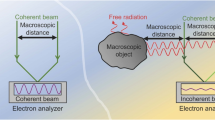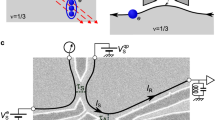Abstract
The complete knowledge of a quantum state allows the prediction of the probability of all possible measurement outcomes, a crucial step in quantum mechanics. It can be provided by tomographic methods1 which have been applied to atomic2,3, molecular4, spin5,6 and photonic states. For optical7,8,9 or microwave10,11,12,13 photons, standard tomography is obtained by mixing the unknown state with a large-amplitude coherent photon field. However, for fermions such as electrons in condensed matter, this approach is not applicable because fermionic fields are limited to small amplitudes (at most one particle per state), and so far no determination of an electron wavefunction has been made. Recent proposals involving quantum conductors suggest that the wavefunction can be obtained by measuring the time-dependent current of electronic wave interferometers14 or the current noise of electronic Hanbury-Brown/Twiss interferometers15,16,17. Here we show that such measurements are possible despite the extreme noise sensitivity required, and present the reconstructed wavefunction quasi-probability, or Wigner distribution function17, of single electrons injected into a ballistic conductor. Many identical electrons are prepared in well-controlled quantum states called levitons18 by repeatedly applying Lorentzian voltage pulses to a contact on the conductor19,20,21. After passing through an electron beam splitter, the levitons are mixed with a weak-amplitude fermionic field formed by a coherent superposition of electron–hole pairs generated by a small alternating current with a frequency that is a multiple of the voltage pulse frequency16. Antibunching of the electrons and holes with the levitons at the beam splitter changes the leviton partition statistics, and the noise variations provide the energy density matrix elements of the levitons. This demonstration of quantum tomography makes the developing field of electron quantum optics with ballistic conductors a new test-bed for quantum information with fermions20,22,23,24. These results may find direct application in probing the entanglement of electron flying quantum bits25, electron decoherence17 and electron interactions. They could also be applied to cold fermionic (or spin-1/2) atoms26.
This is a preview of subscription content, access via your institution
Access options
Subscribe to this journal
Receive 51 print issues and online access
$199.00 per year
only $3.90 per issue
Buy this article
- Purchase on Springer Link
- Instant access to full article PDF
Prices may be subject to local taxes which are calculated during checkout




Similar content being viewed by others
References
Vogel, K. & Risken, H. Determination of quasiprobability distributions in terms of probability distributions for the rotated quadrature phase. Phys. Rev. A 40, 2847–2849 (1989)
Leibfried, D. et al. Experimental determination of the motional quantum state of a trapped atom. Phys. Rev. Lett. 77, 4281–4285 (1996)
Kurtsiefer, C., Pfau, T. & Mlynek, J. Measurement of the Wigner function of an ensemble of helium atoms. Nature 386, 150–153 (1997)
Dunn, T. J., Walmsley, I. A. & Mukamel, S. Experimental determination of the quantum-mechanical state of a molecular vibrational mode using fluorescence tomography. Phys. Rev. Lett. 74, 884–887 (1995)
Shulman, M. D. et al. Demonstration of entanglement of electrostatically coupled singlet-triplet qubits. Science 336, 202–205 (2012)
Medford, J. et al. Self-consistent measurement and state tomography of an exchange-only spin qubit. Nature Nanotechnol. 8, 654–659 (2013)
Smithey, D. T., Beck, M., Raymer, M. G. & Faridani, A. Measurement of the Wigner distribution and the density matrix of a light mode using optical homodyne tomography: application to squeezed states and the vacuum. Phys. Rev. Lett. 70, 1244–1247 (1993)
Breitenbach, G., Schiller, S. & Mlynek, J. Measurement of the quantum states of squeezed light. Nature 387, 471–475 (1997)
Lvovsky, A. I. et al. Quantum state reconstruction of the single-photon Fock state. Phys. Rev. Lett. 87, 050402 (2001)
Bertet, P. et al. Direct measurement of the Wigner function of a one-photon Fock state in a cavity. Phys. Rev. Lett. 89, 200402 (2002)
Houck, A. A. et al. Generating single microwave photons in a circuit. Nature 449, 328–331 (2007)
Hofheinz, M. et al. Synthesizing arbitrary quantum states in a superconducting resonator. Nature 459, 546–549 (2009)
Eichler, C. et al. Experimental tomographic state reconstruction of itinerant microwave photons. Phys. Rev. Lett. 106, 220503 (2011)
Haack, G., Moskalets, M. & Büttiker, M. Glauber coherence of single-electron sources. Phys. Rev. B 87, 201302(R) (2013)
Samuelsson, P. & Büttiker, M. Quantum sate tomography with quantum shot noise. Phys. Rev. B 73, 041305(R) (2006)
Grenier, C. et al. Single-electron quantum tomography in quantum Hall edge channels. New J. Phys. 13, 093007 (2011)
Ferraro, D. et al. Wigner function approach to single electron coherence in quantum Hall edge channels. Phys. Rev. B 88, 205303 (2013)
Dubois, J. et al. Minimal-excitation states for electron quantum optics using levitons. Nature 502, 659–663 (2013)
Levitov, L. S., Lee, H. & Lesovik, G. Electron counting statistics and coherent states of electric current. J. Math. Phys. 37, 4845–4886 (1996)
Lebedev, A. V., Lesovik, G. V. & Blatter, G. Generating spin-entangled electron pairs in normal conductors using voltage pulses. Phys. Rev. B 72, 245314 (2005)
Keeling, J., Klich, I. & Levitov, L. Minimal excitation states of electrons in one-dimensional wires. Phys. Rev. Lett. 97, 116403 (2006)
Beenakker, C. W. J., Emary, C., Kindermann, M. & van Velsen, J. L. Proposal for production and detection of entangled electron-hole pairs in a degenerate electron gas. Phys. Rev. Lett. 91, 147901 (2003)
Beenakker, C. W. J., Titov, M. & Trauzettel, B. Optimal spin-entangled electron-hole pair pump. Phys. Rev. Lett. 94, 186804 (2005)
Sherkunov, Y. B., d’Ambrumenil, N., Samuelsson, P. & Büttiker, M. Optimal pumping of orbital entanglement with single-particle emitters. Phys. Rev. B 85, 081108 (2012)
Yamamoto, M. et al. Electrical control of a solid-state flying qubit. Nature Nanotechnol. 7, 247–251 (2012)
Brantut, J. P. et al. Conduction of ultracold fermions through a mesoscopic channel. Science 337, 1069–1071 (2012)
Polycarpou, C., Cassemiro, K. N., Venturi, G., Zavatta, A. & Bellini, M. Adaptive detection of arbitrarily shaped ultrashort quantum light states. Phys. Rev. Lett. 109, 053602 (2012)
Dubois, J. et al. Integer and fractional charge Lorentzian voltage pulses analyzed in the framework of photon-assisted shot noise. Phys. Rev. B 88, 085301 (2013)
Pedersen, M. H. & Büttiker, M. Scattering theory of photon-assisted electron transport. Phys. Rev. B 58, 12993 (1998)
Dasenbrook, D., Flindt, C. & Büttiker, M. Floquet theory of electron waiting times in quantum-coherent conductors. Phys. Rev. Lett. 112, 146801 (2014)
Bocquillon, E. et al. Coherence and indistinguishability of single electrons emitted by independent sources. Science 339, 1054–1057 (2013)
Acknowledgements
We acknowledge the ERC Advanced Grant 228273 MeQuaNo and thank P. Jacques for technical help, P. Pari, P. Forget and M. de Combarieu for cryogenic support, and P. Degiovanni and C. Grenier for discussions improving the manuscript.
Author information
Authors and Affiliations
Contributions
D.C.G. designed the project. T.J. and P.R. made the measurements and did the data analysis. B.R. contributed to the data analysis. P.R., T.J., B.R. and D.C.G. wrote the article. The sample was provided by Y.J. on wafer from A.C.
Corresponding author
Ethics declarations
Competing interests
The authors declare no competing financial interests.
Supplementary information
Supplementary information
This file contains Supplementary Methods, Supplementary Text and Data, Supplementary Figures 1-3 and additional references. (PDF 540 kb)
Rights and permissions
About this article
Cite this article
Jullien, T., Roulleau, P., Roche, B. et al. Quantum tomography of an electron. Nature 514, 603–607 (2014). https://doi.org/10.1038/nature13821
Received:
Accepted:
Published:
Issue Date:
DOI: https://doi.org/10.1038/nature13821
This article is cited by
-
Coulomb-mediated antibunching of an electron pair surfing on sound
Nature Nanotechnology (2023)
-
Two electrons interacting at a mesoscopic beam splitter
Nature Nanotechnology (2023)
-
Time-resolved Coulomb collision of single electrons
Nature Nanotechnology (2023)
-
Beating Carnot efficiency with periodically driven chiral conductors
Nature Communications (2022)
-
Phase-space studies of backscattering diffraction of defective Schrödinger cat states
Scientific Reports (2021)
Comments
By submitting a comment you agree to abide by our Terms and Community Guidelines. If you find something abusive or that does not comply with our terms or guidelines please flag it as inappropriate.



